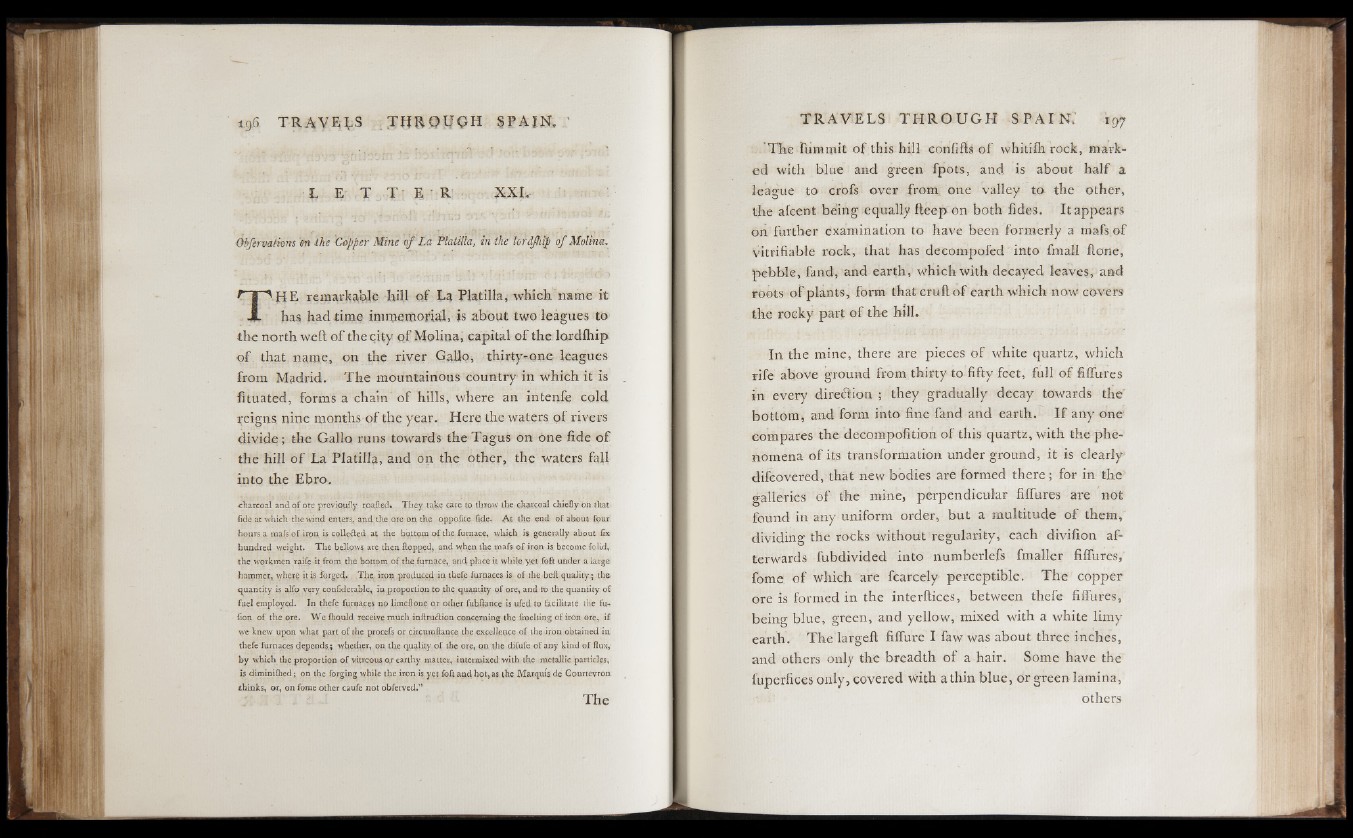
L E T 1 ' E R X X L
OhfervaHons on ihe Capper Mine o f La Platilla, in the lordjhip o f Molina.
THE remarkable hill of La Platilla, which name it
has had time- immemorial, is about two leagues to
the north weft of the city of Molina, capital of the lordfhip
o f that name, on the river Gallo, thirty-one leagues
from Madrid. The mountainous country in which it is
fituated, forms a chain' of hills, where an intenfe cold
areigns. nine months of the year. Here the waters o f rivers
divide; the Gallo runs towards the Tagus on one fide o f
the hill of La Platilla, and on the other, the waters fall
into the Ebro.
charcoal and o f ore previoufly ro.ailed. T h e y take care to throw the charcoal chiefly on that
fide at which the wind enters., arid the ore on the oppofite fide. A t the end o f about four
hours a mafs o f iron is co.lle&ed at the bo,ttopa o f the furnace, which is generally about fix
hundred weight. The bellow^ are then flopped, and when the mafs o f iron is become folid,
the workmen raife it from the bottom.of the furnace, and place it while y e t foft under a large-
hammer, where it is forged. The. icon produced in thefe furnaces, is o f the beft q u a lity ; the,
quantity is alfo very cqnfidefable,,; in proportion to thq quantity o f ore, and to the quantity o f
fuel employed. In thefe fu.rna.ces no limefione or other fuhftance is ufed to facilitate the fu-
fion o f the ore. W e ihould receive much inilru&ion concerning the fine 1 ting o f iron ore, if
we knew upon what part o f the procefs ox circumftance the excellence o f the iron obtained in
thefe furnaces depends,; whether, on, the quality o f the ore, on the difufe o f any kind o f flux,
by which the proportion o f vitreous or earthy matter, intermixed with the metallic particles,
is diminiihed; on the forging while the iron is yet foft and hot, as the Marquis de Courtevron
thinks, or, on fome other caufe not obferyed.”
The fummit of this hill confifb o f whitiih rock, marked
with blue and green fpots, and. is about half a
league to crofs over from one valley to the other,
the afcent being equally fteep on both fides. It appears
on further examination to have been formerly a mafs of
Vitrifiable rock, that has decompofed into final! ilone,
pebble, fand, and earth, which with decayed leaves, and
roots of plants, form that cruft of earth which now covers
the rocky part of the hill.
In the mine, there are pieces of white quartz, which
rife above ground from thirty to fifty feet, full o f fiflures
in every direction ; they gradually decay towards the
bottom, and form into fine fand and earth. I f any one
compares the decompofition of this quartz, with the phenomena
of its transformation underground, it is clearly
difeovered, that new bodies are formed there; for in the
galleries of the mine, perpendicular fiffures are not
found in any uniform order, but a multitude of them,
dividing the rocks without regularity, each divifion afterwards
fubdivided into numberlefs fmaller fiffures,'
fome of which are fcarcely perceptible. The copper
ore is formed in the interftices, between thefe fiffures,
being blue, green, and yellow, mixed with a white limy
earth. The largeft filfure I faw was about three inches,
and others only the breadth of a hair. Some have the
fuperfices only, covered with a thin blue, or green lamina,
others